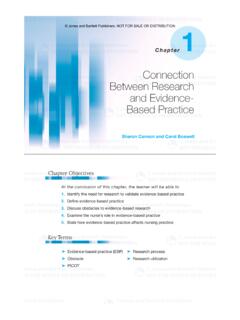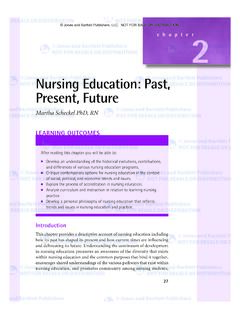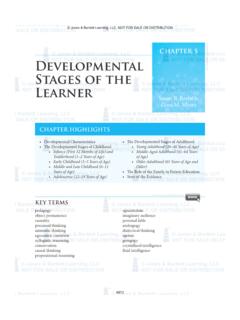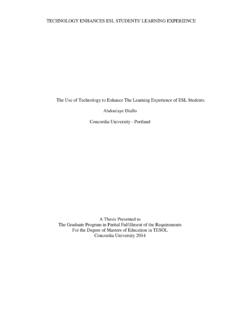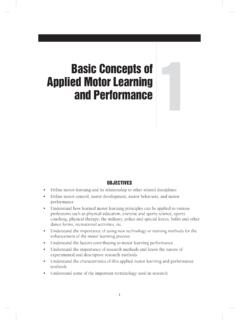Transcription of Chapter 5 Developmental Stages of the Learner Susan B ...
1 Chapter 5 DevelopmentalStages of the LearnerSusan B. BastableMichelle A. DartKEY TERMS pedagogy personal fable object permanence andragogy causality dialectical thinking animistic thinking ageism syllogistical reasoning gerogogy conservation crystallized intelligence imaginary audience fluid intelligence1 Chapter HIGHLIGHTSD evelopmental CharacteristicsThe Developmental Stages of ChildhoodInfancy (First 12 Months of Life) andToddlerhood (1 2 Years of Age) Early Childhood (3 5 Years of Age)Middle and Late Childhood (6 11 Yearsof Age)Adolescence (12 19 Years of Age)The Developmental Stages of AdulthoodYoung Adulthood (20 40 Years of Age)
2 Middle-Aged Adulthood (41 64 Years of Age)Older Adulthood (65 Years of Age and Older)The Role of the Family in Patient EducationState of the 9/14/07 4:39 PM Page 1 Jones and Bartlett Publishers. NOT FOR SALE OR DISTRIBUTION2 Chapter 5: Developmental Stages of the LearnerOBJECTIVESA fter completing this Chapter , the reader will be able to1. Identify the physical, cognitive, and psychosocial characteristics of learners that influencelearning at various Stages of growth and Recognize the role of the nurse as educator in assessing stage -specific Learner needs accordingto maturational Determine the role of the family in patient Discuss appropriate teaching strategies effective for learners at different planning, designing, and implementingan educational program, the nurse as educatormust carefully consider the characteristics oflearners with respect to their developmentalstage in life.
3 The more heterogeneous the targetaudience, the more complex the development ofan educational program to meet the diverseneeds of the population. Conversely, the morehomogeneous the population of learners , themore straightforward the approach to individual s Developmental stage signifi-cantly influences the ability to learn. Pedagogy,andragogy, and gerogogy are three different ori-entations to learning in childhood, young andmiddle adulthood, and older adulthood, respec-tively. To meet the health-related educationalneeds of learners , a Developmental approachmust be used. Three major stage -range factorsassociated with Learner readiness physical,cognitive, and psychosocial maturation mustbe taken into account at each developmentalperiod throughout the life cycle.
4 Developmental psychologists have for yearsexplored the various patterns of behavior partic-ular to Stages of development. Educators, morethan ever before, acknowledge the effects ofgrowth and development on an individual s will-ingness and ability to make use of Chapter has specific implications forstaff nurses and staff development and in-servicenurse educators because of the recent mandatesby the Joint Commission (formerly known asthe JCAHO the Joint Commission on Ac-creditation of Healthcare Organizations). Forhealthcare agencies to meet Joint Commissionaccreditation requirements, teaching plans mustaddress stage -specific competencies of thelearner.
5 In this Chapter , the distinct life Stages oflearners are examined from the perspective ofphysical, cognitive, and psychosocial develop-ment; the role of the nurse in assessment ofstage-specific Learner needs; the role of the fam-ily in the teaching learning process; and theteaching strategies specific to meeting the needsof learners at various Developmental Stages deliberate attempt has been made to mini-mize reference to age as the criterion for catego-rization of learners . Research on life-spandevelopment shows that chronological age per seis not the only predictor of learning ability(Santrock, 2006; Vander Zanden, Crandell, & 9/14/07 4:39 PM Page 2 Jones and Bartlett Publishers.)
6 NOT FOR SALE OR DISTRIBUTIOND evelopmental Characteristics3 Crandell, 2007; Whitener, Cox, & Maglich,1998). At any given age, one finds a wide varia-tion in the acquisition of abilities related to thethree fundamental domains of development:physical (biological), cognitive, and psychosocial(emotional-social) maturation. Age ranges,included after each Developmental stage headingin this Chapter , are intended only to be used asapproximate age-strata reference points or gen-eral guidelines; they do not imply that chrono-logical ages necessarily correspond perfectly tothe various Stages of development.
7 Thus, theterm Developmental stage will be the perspectiveused based on the confirmation by psychologiststhat human growth and development aresequential but not always specifically age it has become clear that develop-ment is contextual. Even though the passage oftime has traditionally been synonymous withchronological age, social and behavioral psy-chologists have begun to consider the manyother changes occurring over time that affect onthe dynamic relationship between a humanbeing s biological make up and the is now understood that three important con-textual influences act on and interact with theindividual to produce development (Santrock,2006; Vander Zanden et al.)
8 , 2007):1. normative age-graded influences arestrongly related to chronological ageand are similar for individuals in a par-ticular age group, such as the biologicalprocesses of puberty and menopause,and the sociocultural processes of transi-tioning to different levels of formal edu-cation or to normative history-graded influences arecommon to people in a particular agecohort or generation because they havebeen uniquely exposed to similar histor-ical circumstances, such as the VietnamWar, the age of computers, or the ter-rorist event of September 11, normative life events are the unusual orunique circumstances, positive or nega-tive, that are turning points in someone slife that cause them to change direction,such as a house fire, serious injury in anaccident, winning the lottery, divorce, oran unexpected career this Chapter focuses on the patientas the Learner throughout the life span, thestage-specific characteristics of adulthood andthe associated principles of adult learning pre-sented herein can be applied to any audience ofyoung, middle, or older adult learners , whetherthe nurse is instructing the general public in thecommunity.
9 Preparing students in a nursingeducation program, or teaching continuing edu-cation to staff nurses. DevelopmentalCharacteristicsAs noted, actual chronological age is only a rela-tive indicator of someone s physical, cognitive,and psychosocial stage of development. Uniqueas each individual is, however, some typical devel-opmental trends have been identified as mile-stones of normal progression through the lifecycle. When dealing with the teaching learningprocess, it is imperative to examine the develop-mental phases as individuals progress frominfancy to senescence so as to fully appreciate thebehavioral changes that occur in the cognitive,affective, and psychomotor domains.
10 As influential as age can be to learning readi-ness, it should never be examined in 9/14/07 4:39 PM Page 3 Jones and Bartlett Publishers. NOT FOR SALE OR DISTRIBUTION4 Chapter 5: Developmental Stages of the LearnerGrowth and development interact with experi-ential background, physical and emotionalhealth status, and personal motivation, as wellas numerous environmental factors such asstress, the surrounding conditions, and theavailable support systems, to affect a person sability and readiness to (1999) describes three phases oflearning: dependence, independence, and inter-dependence.
